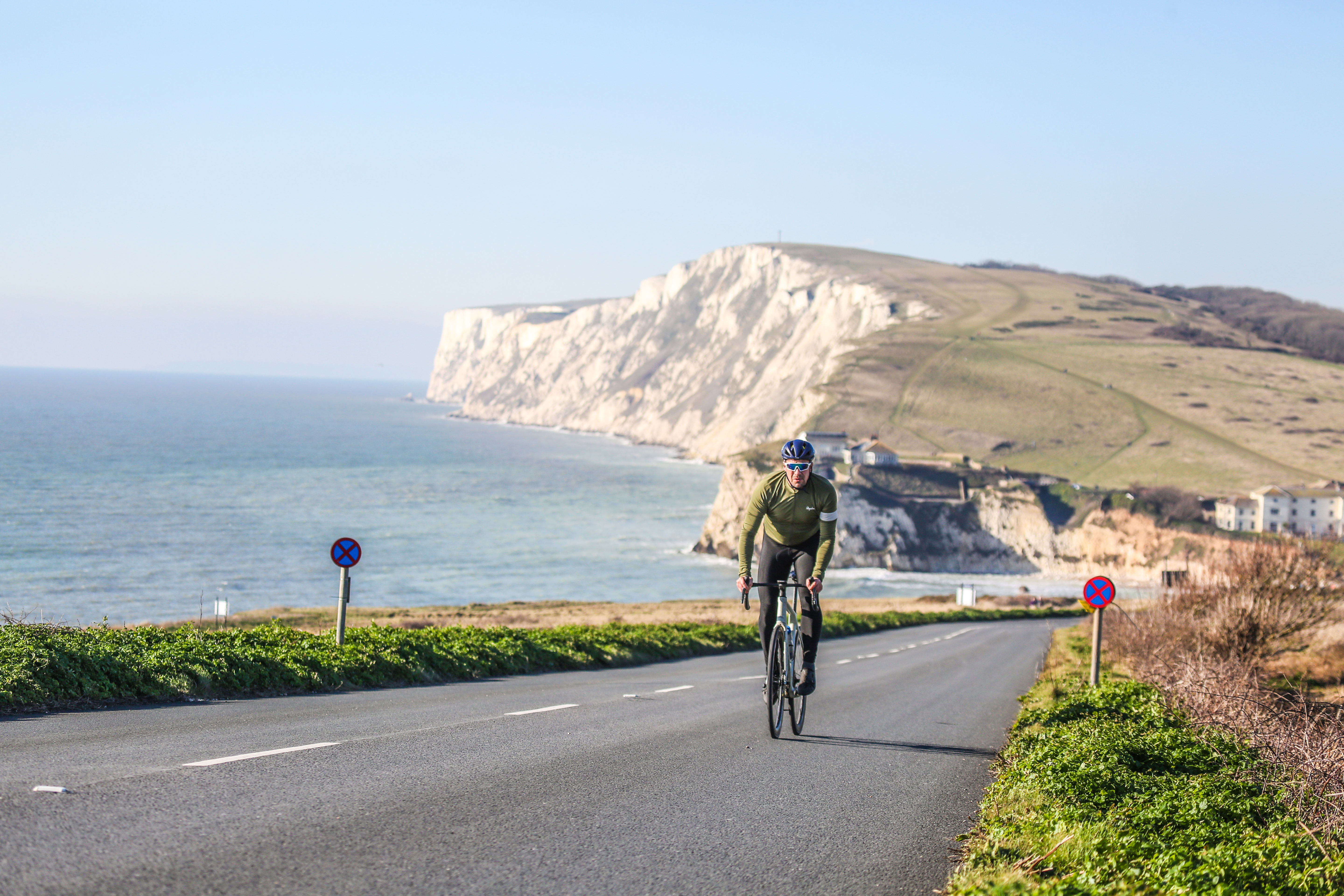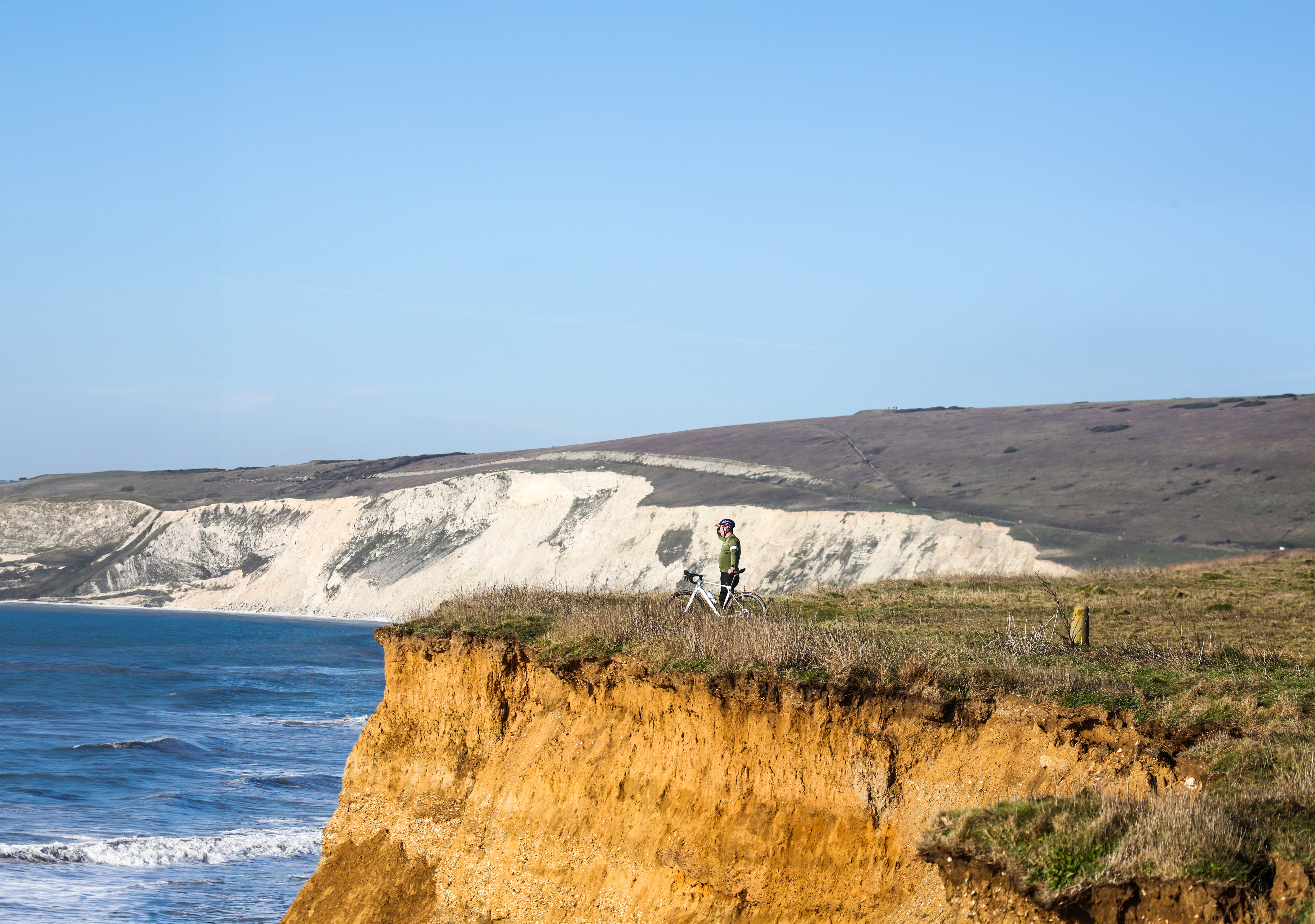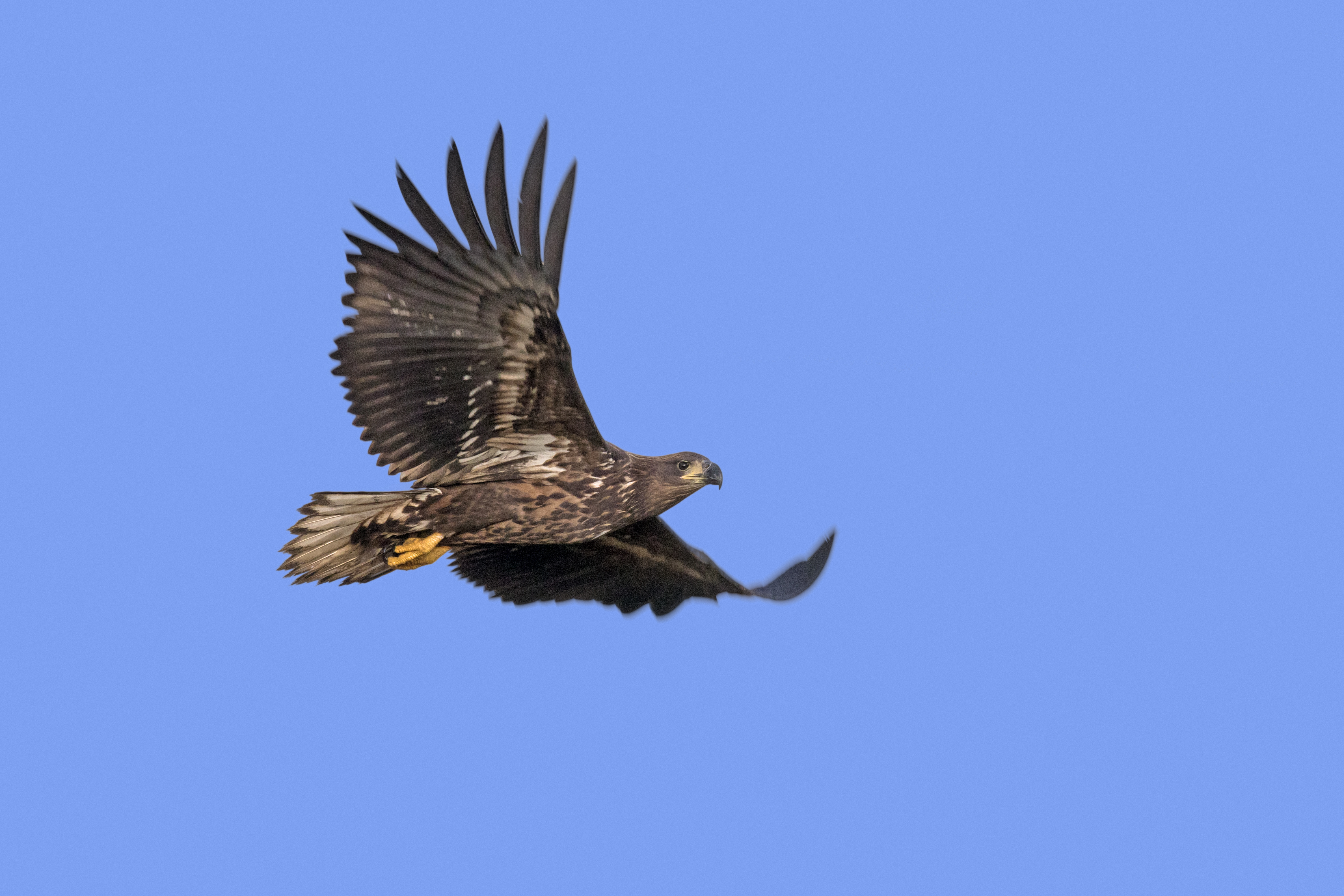Hunting an Eagle on the Isle of Wight - how a bike ride got me hooked on finding Britain's biggest bird of prey
Isle of Wight is home to one of Europe's largest birds of prey, the majestic white-tailed eagle - but can it be found by bike?

Crossing the Solent from Southampton to East Cowes only takes an hour. Before your cappuccino has cooled, a captivating sight hoves into view: a colossal, 12-by-65-metre mural adorning the shipyard's Columbine Building. From far out to sea, you can make out the brown plumage, and as you get closer, the bright yellow talons and hooked bill sharpen into focus. It's a stunning artwork, executed with lifelike precision.
The majestic animal it depicts is the largest bird of prey to grace UK shores, and its presence here is the culmination of a remarkable conservation success story of which the Isle of Wight is rightly proud. It was late January, and as I exited the port, the towering mural served as an unsubtle reminder of the purpose of my trip.
Upon pitching the idea to the features editor, his uncompromising reply was: sounds great - provided you actually see one. Of course I will, I assured him. With my Canyon Endurace in tow, I had one job: to glimpse, and hopefully photograph, a bird with a two-metre wingspan - how could I fail to spot one?
My optimism had firmer roots, too. The white-tailed eagle is a native species but was relentlessly persecuted by hunters and gamekeepers, going extinct in the early 20th Century. Since the reintroduction programme began in 2019, 13 white-tailed eagles have been released on the Isle of Wight. These majestic raptors have become familiar figures among locals - their population currently at 22 - and I was eager to encounter one.

You have to be prepared to go off road in the hunt for wildlife
Wildlife by Wheels
My love of birdwatching took off around the same time I started riding a road bike. While some view cycling as a quest for ever greater speed, I've discovered that slowing down and immersing myself in my surroundings is where the bigger thrills lie. The bike offers a unique blend of stealth, speed and surprise; unless yours has a ferociously noisy freehub, you can get up close with species that might otherwise be missed.
I've had buzzards flap their wings in my face, and my only sightings of live badgers have been from the saddle. You can practically take afternoon tea with a bevvy of deer before they eventually realise that you're the only one in Lycra. But I suspected the white-tailed eagle might prove a more elusive guest.
In a bid to maximise my chances of spotting one, I met up with Forestry England's Steve Eggerton-Read, the reintroduction project manager, the morning after my arrival on the island. "Coastal areas like Brading Marshes on the east of the island near Bembridge are great places to glimpse them," he told me. "There are lots of other birds to see there too, and it's good viewing from the bike at the road bridge at Embankment Road near St Helen's," Eggerton-Read continued. "On the other side of the island, Tennyson Down, near the Needles, is also a good place to spot them."
The latest race content, interviews, features, reviews and expert buying guides, direct to your inbox!
The Quest Begins
My route had now been established: starting at Tennyson Down, I'd cover the entire 23-mile width of the island, riding east towards Brading Marshes, and taking in other hotspots including Mottistone Down, Brighstone Down and Chale. As the eagle flies, it's not far, but it undulates like an Ardennes Classic - the first 10 miles, for example, would see me notch up 1,500ft of elevation, a daunting prospect for legs more accustomed to the virtual elevations of Zwift. Armed with a small pair of binoculars, tucked in the pocket of the most inconspicuous jersey I could find, I set off from Tennyson Down and skirted the coast.
I kicked through my first pedal-strokes with a childlike excitement. To me, the white-tailed eagle was the holy grail. Take your first kingfisher sighting, multiply it by 20, and you're probably entering the realms of the rush I was expecting. Finally, I'd be able to say: "Bird-spotting? Completed it, mate". Until then, I'd revel in the isolated roads.
Although visible from the mainland, the Isle of Wight is a world away from the traffic horrors and sketchy tarmac of England proper. Even the main Military Road was void of cars as cyclists made the most of the sunniest day of the year so far. After such a wet and dark winter, this was a ride tinged not only in hope of seeing a white-tailed eagle, but also with a promise of nearing spring and longer, warmer days on the bike. It wasn't quite time to bare arms and legs yet, but after negotiating some rolling coastal blacktop, I'd generated enough heat and life was now very comfortable indeed. I kept an eye out to sea. As much as I wanted to see an eagle, I was also keen not to taste the island tarmac, so fleeting glimpses out to the horizon were as much as I was willing to dare. I'd take regular breaks to brandish the binoculars and scour the sky for raptors.
Head to the Heights
As I continued towards Brook, the sky came alive with birdlife. First I saw a sparrowhawk hunting on the wing. Meanwhile, just beyond in the adjoining field, a clamour of rooks rose hysterically, squawks of contempt filling the air. Recalling Eggerton-Read's advice, I knew that such unrest among birds often signals the presence of a predator. Though white-tailed eagles usually feed on fish, it's not unusual for juveniles to pinch prey from other species of bird-carrion is their fare of choice while finding their sea legs. Had a young eagle come to purloin the rooks' mid-morning snack? Not for the moment; perhaps the sparrowhawk had unsettled them.

On the Isle of Wight, you're never far from the coast
Continuing inland from the coast on a network of deliciously empty country lanes, I climbed up towards Mottistone Down. Despite today's warmth, the hedgerows remained threadbare, crisscrossing an expanse of winter forage crops, while at the roadside budding snowdrops were being stirred into action by the sunshine - their white flecks reminding me of a certain white tail. I had a job to do-and for the first time today I called on my fast-twitch muscle fibres to hasten me up the hill.
White-tailed eagles gravitate to marshes and coastal areas, Eggerton-Read had told me, recommending lofty vantage points. I rode to the ridge at top of Lynch Lane, took a swig from my bidon, broke out the binos and settled in for 15 minutes of hardcore twitching. You don't need any visual assistance to see just how beautiful the Isle of Wight is from up here. To the west, where I began my ride, chalky cliffs plunged into the English Channel, while just over the horizon to the north, a sparkling Solent hosted a flotilla of yachts.
Meanwhile on terra firma, above me a kestrel hovered, its talons flexed in preparation for a kill. Over a copse on a neighbouring ridge, I heard the plaintiff call of a buzzard. But nary a sign of an eagle. "You'll know if you've seen one," Eggerton-Read had told me with a wry smile. Even without wings outstretched, they stand at almost a metre tall. It would be impossible to miss a 'flying door' in the sky.
Kestrel, sparrowhawk and buzzard ticked off, I put my gloves back on and headed east. The wind was starting to bite and a brisk, warming effort was called for. I picked up the coastal road again and passed a group of riders in the finery of the West Wight Wheelers. What a blessed bunch being able to ride around here every day, I thought.
Stopping at a coffee van for a roadside mocha, I asked the proprietor if he'd seen any eagles. Politely, he gestured towards a blackboard at the side of the van that read: 'Birds spotted here today: Jackdaws, meadow pipits, stone chats, rooks'. All the usual suspects had been in attendance, but no mention of my white-tailed prize. "Five flew over here at the same time towards the beginning of January," he said, handing over my steaming cup. "I guess you've just got to be lucky."
With the sky bruising, I covered the 10 miles between Godshill and Brading buffeted by an easterly breeze. I had one twitching spot left, and I wasn't giving up yet. The sun was just setting as I arrived at what's considered a prime eagle-spotting location. A huddle of birders stood at the edge of a wetland. A marsh harrier flew by, a first sighting for me. Then came a barn owl, always a breathtaking sight. Anywhere else, I'd consider this a red letter day. But the eagle appeared destined not to land. In hindsight I would've been extremely lucky to see one. This was my first outing with the explicit intention of spotting a sea eagle and, as any seasoned twitcher would concur, it's always when you're least expecting it - and usually when you don't have a camera- that the bird you've been tracking decides to cast a shadow.
I enjoyed a day's ride around this unsung little island, and had done so in the company of some A-list raptors. The stars of the show, however, had failed to turn up to their own party. Still, there's reason for optimism. With young white-tailed eagles being reared and released every year, it's only a matter of time before I get to see one. The thrill, as they say, is in the chase... I'll be back.

Eagle Stats!
1780 - the year the last pair of white-tailed eagles bred on Culver Cliff, Isle of Wight, before the species was hunted to extinction
2019 - the year the reintroduction scheme began on the Isle of Wight, with a licence to release up to 60 juveniles
1.8-2.4 meter wing-span of the white-tailed eagle (5ft 10in to 7ft 10in)
37 eagles have been released on the Isle of Wight since 2019
6-8 breeding pairs are hoped to become established on the Isle of Wight
40% of white-tailed eagles survive to breeding age
2,000 kilometres was the distance one eagle, tagged G818, travelled over just 22 days, visiting Normandy and Brittany before returning
30% of the white-tailed eagle's diet is made up of carrion
130 breeding pairs are in Scotland following successful reintroduction
£5,000,000 is estimated to have been contributed to the Isle of Mull's economy from the reintroduction of white-tailed eagles
Steve has been writing (mainly fitness features) for Cycling Weekly for 11 years. His current riding inclination is to go long on gravel bikes... which melds nicely with a love of carbs
You must confirm your public display name before commenting
Please logout and then login again, you will then be prompted to enter your display name.